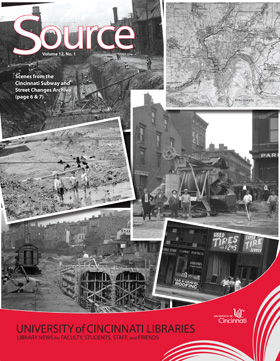In order to provide maintenance to the UC Library Catalog, all applications within the Library Catalog, including web access, will be offline from approximately 6:15pm to 6:35pm Friday, March 29, 2013.
Author Archives: Melissa Cox Norris
Hungry?! Bite into an Edible Book with UC Libraries
 Once again, the University of Cincinnati Libraries will celebrate the International Edible Books Festival with an event scheduled for Monday, April 1 from 12:30-1:30pm on the 5th floor lobby of Langsam Library.
Once again, the University of Cincinnati Libraries will celebrate the International Edible Books Festival with an event scheduled for Monday, April 1 from 12:30-1:30pm on the 5th floor lobby of Langsam Library.
At the event, nearly 20 participants will present their edible creations that represent a book in some form.
HSL Lunch & Learn Videos Available
Miss the Health Sciences Library’s February Lunch & Learn series? Don’t worry! You can now watch all four instruction sessions online. Check out videos by following the links below. The videos are also available on the HSL’s Tutorials guide at http://guides.libraries.uc.edu/hsltutorials.
Excel Tricks: Learn about some of the newer features available in Excel to make you a more effective user.
Free Screencasting Tools: Learn the basics on how to record a video of what you do on a computer screen using two free screencasting tools, Screencast-O-Matic and Jing.
iPad 101: A beginners’ look at iPads, including settings and some helpful apps.
Time Saving Tech Tips: Learn to leverage productivity apps (Evernote) and shortcuts to save you time and hassle.
Note: Videos are available in WMV format.
Read SOURCE for Library News and Information
The Vol. 12, No 1. issue of Source, the UC Libraries newsletter for faculty, students, staff, and Friends, has published and is being distributed throughout the libraries and campus.
It can also be read online.
Undergraduate Discovery: Cross-Disciplinary Discussion with UC Undergraduates
 In partnership with UC Libraries, the Office of Undergraduate Research, Scholarly Endeavors & Creative Practice (URSC) presents a new undergraduate student lecture series on Tuesday, March 12, 4-6 p.m., Langsam Library 4th floor (near Triceracopter). Scheduled once per semester, Undergraduate Discovery: Cross-Disciplinary Discussion with UC Undergraduates will feature recipients of the URSC Student of the Month Awards for spring 2013 semester.
In partnership with UC Libraries, the Office of Undergraduate Research, Scholarly Endeavors & Creative Practice (URSC) presents a new undergraduate student lecture series on Tuesday, March 12, 4-6 p.m., Langsam Library 4th floor (near Triceracopter). Scheduled once per semester, Undergraduate Discovery: Cross-Disciplinary Discussion with UC Undergraduates will feature recipients of the URSC Student of the Month Awards for spring 2013 semester.
Books Good Enough to Eat
 Create an Edible Book for the International Edible Books Festival, Monday, April 1, at 12:30pm in the 5th floor lobby of Langsam Library.
Create an Edible Book for the International Edible Books Festival, Monday, April 1, at 12:30pm in the 5th floor lobby of Langsam Library.
For the 11th year, the University of Cincinnati Libraries will celebrate the International Edible Books Festival with an event scheduled for Monday, April 1, 2013, from 12:30-1:30pm in the 5th floor lobby of Langsam Library. Continue reading
The Albert B. Sabin Digitization Project: National Medal of Science 50th Anniversary
 The National Science Foundation (NSF) is celebrating the 50th anniversary of the National Medal of Science with a new online exhibit. In 1959, President Dwight D. Eisenhower signed legislation creating the National Medal of Science. President John F. Kennedy awarded the first medal to Theodore von Kármán in 1963. This new exhibit features some of the 476 men and women who have been recognized for “their outstanding contributions to knowledge in the physical, biological, mathematical, or engineering sciences,”[1] including our own Dr. Albert Bruce Sabin. Continue reading
The National Science Foundation (NSF) is celebrating the 50th anniversary of the National Medal of Science with a new online exhibit. In 1959, President Dwight D. Eisenhower signed legislation creating the National Medal of Science. President John F. Kennedy awarded the first medal to Theodore von Kármán in 1963. This new exhibit features some of the 476 men and women who have been recognized for “their outstanding contributions to knowledge in the physical, biological, mathematical, or engineering sciences,”[1] including our own Dr. Albert Bruce Sabin. Continue reading
UC Faculty & Library Staff: Submit Your 2012 Published Works to Authors, Editors & Composers
 On Tuesday, April 9, 2013, the University of Cincinnati Libraries will once again recognize the publishing and creative accomplishments of UC’s faculty at the annual “Authors, Editors & Composers” event. Scheduled for 3:30pm in the Russell C. Myers Alumni Center at UC, “Authors, Editors & Composers” will include a reception, presentation of selected works, a printed bibliography, and an exhibit. Continue reading
On Tuesday, April 9, 2013, the University of Cincinnati Libraries will once again recognize the publishing and creative accomplishments of UC’s faculty at the annual “Authors, Editors & Composers” event. Scheduled for 3:30pm in the Russell C. Myers Alumni Center at UC, “Authors, Editors & Composers” will include a reception, presentation of selected works, a printed bibliography, and an exhibit. Continue reading
Database Provides Access to Newspapers Published by or for African Americans
Through a partnership with the Taft Collections Committee, UC Libraries has added an important primary source for the study of African American history, life, and culture: African American Newspapers, 1827-1998 Connect . Continue reading
HSL Tutorials
Not sure how to access full text articles? Never requested journal articles using the online request system ILLiad?
Check out the Tutorials CampusGuide at http://guides.libraries.uc.edu/hsltutorials . This Guide includes many other tutorials including: Continue reading

